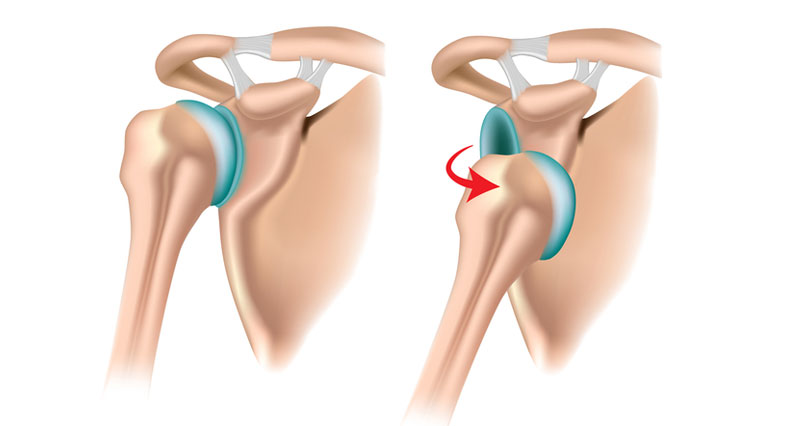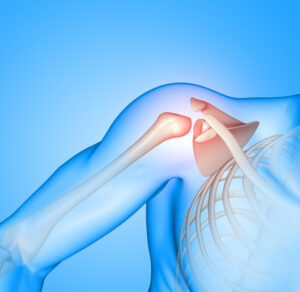Before knowing about Shoulder Dislocation, let us know something about the shoulder, which has the greatest range of motion of any joint in the human body, and can become restricted after a dislocation. The ball and socket within the shoulder separate during a dislocated shoulder. As a result, the shoulder might dislocate in all directions, including multiple directions in some cases. The likelihood of a shoulder dislocating once again increases. When the muscles, tendons, bones, and ligaments that surround the shoulder do not function properly to secure the ball and socket joint, shoulder instability develops.
Symptoms & Causes
Symptoms of a Dislocated Shoulder
Common dislocated shoulder symptoms include:
- Significant pain can also be felt in the arm
- Inability or difficulty moving the arm
- Arm numbness
- A “popping” sensation
- Shoulder weakness
- Loss of range of motion
- Visual deformity of the shoulder joint

Causes of shoulder dislocation encompass:
1. Sports-related injuries: Dislocation of shoulder frequently occur in contact sports like football and hockey, as well as activities with the potential for falls like skiing, gymnastics, and volleyball.
2. Non-sports trauma: Sudden impacts, such as those from motor vehicle accidents, can result in dislocated shoulder.
3. Falls: Awkward landings following falls, such as from ladders or tripping on rugs, can lead to dislocation of shoulder.
Types of shoulder dislocation
Orthopedic doctor categorizes recurrent dislocation of shoulder based on the extent of bone movement within your joints:
-
Complete dislocations (luxation)
This occurs when the joint bones are entirely separated and displaced.
-
Subluxation
Subluxation is one of the types of shoulder dislocation, where the joint is partially separated, with bones touching but not completely as usual. It is also known as partial dislocation.
Risk factors for shoulder dislocation
While dislocation of shoulder can affect anyone, certain individuals are at increased risk, including:
1. Athletes engaged in contact sports.
2. Males and individuals assigned male at birth (AMAB).
3. Individuals aged 15 to 30 years.
4. Those with a history of previous shoulder dislocations.
Men and individuals assigned male at birth (AMAB) have more than double the likelihood of experiencing a shoulder dislocation compared to women and individuals assigned female at birth (AFAB).
What are the potential complications of a dislocated shoulder?
Common complications of shoulder dislocation involve damage to surrounding bones and tissues, including:
- Bone fractures.
- Sprains of ligaments and tendons.
- Nerve damage.
- Injury to blood vessels.
- Muscle strains
Additionally, some individuals may develop a Hill-Sachs lesion, which resembles a dent in the upper humerus ball. This can occur if the humerus is pressed against the socket’s edge in the scapula during dislocation, resulting in damage to the humeral head.
Diagnostic Procedures:
While X-ray is usually sufficient to diagnose shoulder dislocation, CT and MRI scans are frequently necessary to detect subtle fractures of the glenoid rim or ligament/tendon injuries, respectively
Treatment & Management of Dislocated Shoulder
Treatment for Dislocated Shoulders:
Seek immediate medical attention if you suspect a dislocation. The primary treatment involves closed reduction or manipulation, where a healthcare provider realigns the shoulder joint externally. Avoid attempting self-reduction and refrain from allowing untrained individuals to manipulate the shoulder.
After reduction, additional treatments may include:
- Immobilization: Wearing a splint or sling to support the shoulder and promote healing, along with icing and light exercises as advised.
- Medication: Prescription medication for pain and inflammation management.
- Rest: Avoiding activities that strain the shoulder.
- Physical Therapy: Gradual introduction of motion exercises to reduce stiffness and later, strengthening exercises under the guidance of a provider or physical therapist.
How long does it take to recover from a dislocated shoulder?
Usually, it takes several months to recover from any type of shoulder dislocation. Immobilization of the shoulder is required for a few weeks, followed by months of physical therapy after the joint has healed. Consult your healthcare provider for guidance on when it’s safe to resume physical activities to minimize the risk of re-injury, including another dislocation.
Prevention from Dislocation of Shoulder
To reduce the risk of a dislocated shoulder:
- Be cautious to prevent falls and shoulder injuries.
- Use suitable protective gear when participating in contact sports.
- Maintain regular exercise to strengthen and keep joints and muscles flexible.
Individuals who have experienced a dislocated shoulder should continue prescribed strength and stability exercises to lower the likelihood of future dislocations.
